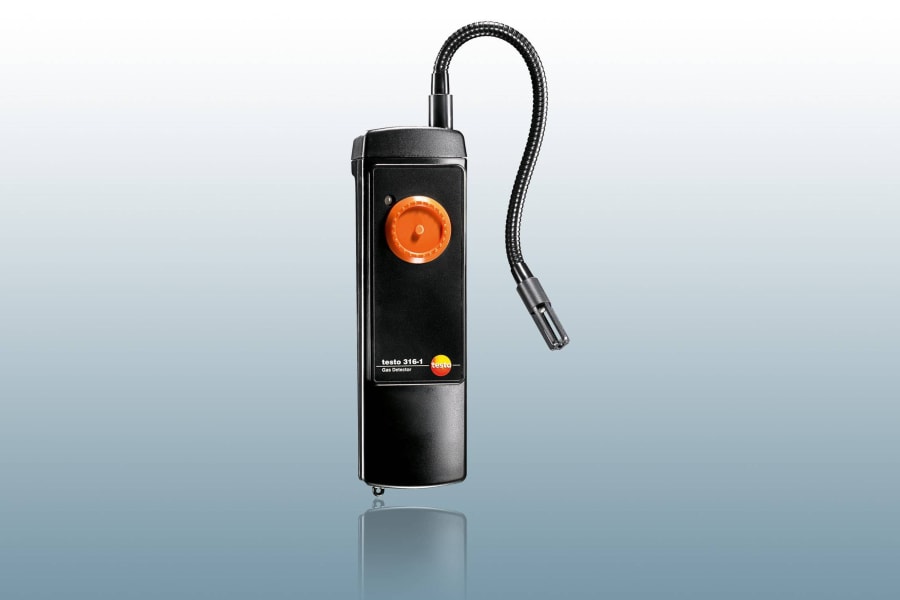Flue gas measuring instruments for industry
Flue gas analysis in industrial installations often needs to be carried out in extreme conditions, involving high temperatures, high humidity or a high dust content in the flue gas, for example. Emission measurements are taken in resource- and energy-intensive processes, during which large quantities of emissions such as carbon monoxide (CO), carbon dioxide (CO2), nitrogen oxides (NOX) or sulphur dioxide (SO2) are produced.

With a number of exhaust gas probes, sensors and special options such as automatic dilution or Peltier gas preparation, the exhaust gas analyzers from Testo were specially developed for extreme demands. Emission analyser applications are included in industrial areas such as cogeneration plants, boiler plants, metal works, gas turbines, engines and mining. A testo emission analyser is designed to withstand the intense conditions of these environments and to help you take accurate readings throughout.
A flue gas analyzer from Testo offers you
Numerous measurement parameters: O2, CO, NO, NO2, SO2, CO2, H2S
Extensive selection of probes
Fast access to sensors and wearing parts
Measurement data management via software
Testo emission analyzers for portable, industrial emission measurement
Industrial flue gas analysis
This comprehensive reference guide offers you practical tips and tricks relating to emissions measurements.

The combustion process
Practical knowledge for work in the field
Gas analysis technology
Industrial gas analysis applications
Testo gas analysis technology
And much more ...
Further information about flue gas analysis and emission measurement
Applications
When analyzing the burner’s behaviour, the focus of attention is often on fuel supply, atomization, control behaviour and emissions values.
The flue gas analyzers enable all relevant gases to be analyzed and the combustion process to be adjusted so that the best possible ratio of fuel to combustion air quantities is achieved.

Effective flue gas measurement with the testo 300 NEXT LEVEL
Use the testo 300 NEXT LEVEL flue gas analyzer to carry out flue gas measurements easily and efficiently, even on larger systems:
Wireless parallel measurements in record time
Practical second screen function
Easy, intuitive documentation and data integration with your in-house software
Flue gas analysis with Testo: professional and reliable.
Flue gases contain, among others CO2, CO, oxides or soot particles. These pollute the environment, have a negative effect on the climate and conceal numerous health risks for human beings. Flue gas analysis with professional flue gas analyzers from Testo helps to make combustion processes more efficient, to optimize thermal processes, and above all, to reduce emissions.
Protection of the atmosphere thanks to as low a pollutant level as possible
The most efficient use of energy possible
Adherence to prescribed pollutant levels per exhaust gas volume and energy loss

A detailed look at particulate matter measurement
In the measurement of fine particles, whether you are a chimneysweep or a heating fitter, the instruments eliminate the need for any further instructions. You can obtain very accurate and reliable data with the instrument. The design of Testo's products means they can be used for all fuel classes. In this respect, the A, B and C fuel classes are covered. In addition, there are limit values which have to be complied with and that can be displayed by a flue gas analyzer. Levels 1 and 2 can also be detected using the instruments.
If you establish that the particulate matter exposure is too high, depending on the instrument, you can also use a leak detector.
fast system checking
detection of leaks within a short period of time
reliable data on the sizes of the particulate matter being emitted

Working with an instrument for measuring the degree of blackening
One of the smoke count measuring instruments is the degree of blackening measuring instrument. It is possible to take this instrument with you and thus use it at different operating locations. This special particulate matter measuring device can carry out a direct analysis. That is particularly important in terms of ensuring you have the data to hand on site and are able to respond. It is of particular importance when it comes to controlling diesel motors. In this way, the occurrence of emissions should be avoided. Injection can also be adjusted on a diesel engine to reduce the emission of soot.
This is especially important so that you have the data ready to hand on site and can react. This is important in particular with regard to testing diesel engines. This way, the occurrence of emissions is prevented. A diesel engine’ injection can also be adjusted in order to reduce the soot emission.
The instruments in Testo's range are also suitable for industrial use. It is therefore unimportant whether the diesel engines you wish to test are in vehicles, industrial plants or on ships. Measurement systems no longer need to be installed on site. This is a crucial cost saving.






























